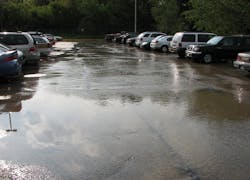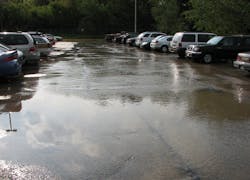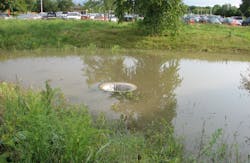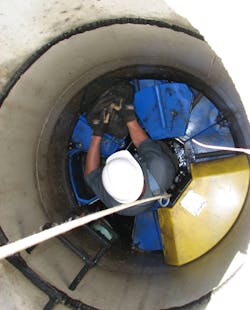Stormwater Filtration Helps Airport Expansion Clear for Take-off
The Dane County Regional Airport in Wisconsin, US had to increase its stormwater capacity to meet requirements of treating 40% of total suspended solids. This article looks at why a final filtration solution was chosen as part of small retention pond.
By Natasha Wiseman
Airports are often a big contributor to stormwater loading due to extensive roofed buildings and other impervious surfaces including the runway, taxiways, apron, access roads and parking lots. The stormwater runoff may be polluted with hydrocarbons from fuel, de-icer residues, suspended sediments, particulate and dissolved metals and wind-blown trash.
While many airports were built before environmental regulation required them to conform to stormwater quantity and quality standards, any facilities undergoing expansions or new construction must comply.
Airports are usually constructed on flat ground either on a plain, or on a valley floor. The topography therefore puts flow restrictions on the drainage, because achieving sufficient head for efficient water flow over long distances requires careful design and planning. Flat topography also favours temporary standing water; all things considered, airport drainage is a complex subject.
No compromise on safety
Another factor that must be considered is aircraft safety. In addition to reducing the standing water hazard on runways, airports spend time and money to minimise hazards from bird strikes on aircraft by reducing attractions for birds.
Temporary or permanent surface water pools that could attract water fowl to the vicinity of an airport are considered dangerous. Along migration routes such as the Mid-West corridor, where large waterfowl move in huge seasonal numbers, extra care must be taken.
Conventional land-based methods of managing airport runoff, such as temporary ponds and wetlands, therefore run counter to Federal Aviation Authority (FAA) guidelines, which do not allow ponds that retain water for longer than 48 hours.
Airport expansion
This was the situation facing Dane County Regional Airport, in Wisconsin, which is a joint civil-military commercial airport serving the Madison area in south-central Wisconsin.
It is the second largest airport in the state, with more than 100 daily flights and more than 1.6 million passengers passing through each year. In recent years, the airport has undertaken a series of construction projects, adding new runways, parking facilities, airport ramps and office space.
One of these projects involved rebuilding an access road around the airport and resurfacing 5.3 acres of parking lots. To meet State stormwater regulations for this development, airport officials were required to increase the capacity of their existing stormwater treatment system, which included a small retention pond.
A traditional solution to increasing the airport's stormwater treatment capacity might include expanding the size of the existing pond. However, the location of the pond in relation to the runways could have created a problem by attracting large water birds that posed a danger to aircraft.
Best Management Practice
The airport needed a structural Best Management Practice (BMP) that could meet the Wisconsin Department of Natural Resources' (DNR) redevelopment requirement of treating 40% of the Total Suspended Solids (TSS) in runoff from the new and redeveloped impervious surfaces, without creating any standing water.
At the same time, Dane County airport officials would not expand the existing stormwater pond even though it was designed to stay dry except during heavy rain events because of FAA guidelines.
Additionally, there was limited space and existing drainage infrastructure that could not be abandoned. After evaluating various conventional BMPs based on land take and retrofitability, manufactured treatment devices (MTDs) were considered to be the most practical type of structural BMP.
Existing drainage
Project team members from the airport and GRAEF, Inc., its consulting engineer on the project, reviewed several manufactured filtration systems before choosing the Up-Flo® Filter from Hydro International. The Wisconsin DNR requires treatment options to be modeled in WinSLAMM, a Source Loading and Management software program developed by PV & Associates.
Using real rainfall data from Madison Airport, WinSLAMM was used to generate probability distributions of flows that were expected from the 5.3 acre site. Planned for release late in 2014 version 10.2 of WinSLAMM will have the Up-Flo filter coded in as a standard BMP option and will allow engineers to size the filter according to the treatment goals.
Performance data from filter field testing was applied to the WinSLAMM outputs to determine the size required to comply with the DNR's goal of 40% TSS reduction.
The filtration system removes trash, sediment, nutrients, metals and hydrocarbons from stormwater runoff. In terms of maintenance, confined space-trained personnel with a standard vactor truck can clean the sump and change the filter bags in less than an hour. No cranes or heavy lift equipment are required to remove or install the bags.
Low head, high efficiency
GRAEF initially chose the Filter based on cost per filtered flow rate. It was soon realised that the filtration product could operate with a 9-inch drop between inlet and outlet and filter more than 100 gpm with only 20 inches of driving head, on an overall water elevation difference of about 2.5 feet.
The pre-existing stormwater pond discharges into Starkweather Creek, which feeds into Lake Monona near downtown Madison. To minimise construction costs and fully take advantage of the filter unit's intended use for source control, GRAEF construction engineer Ed Premo placed it upstream of the existing pond. In this position it intercepts the majority of the most frequently occurring runoff.
"The pond and adjacent storm sewer emptying in Starkweather Creek are free of sediment, and to this date the maintenance has been very minimal," Ed Premo, construction engineer at GRAEF.
"The device chosen was the most economical option and solved an issue that the Wisconsin DNR had with the additional parking areas the airport had planned for the desired growth of business. The pond and adjacent storm sewer emptying in Starkweather Creek are free of sediment, and to this date the maintenance has been very minimal."
An existing catch basin was modified to divert over 50% of the annual runoff to the filter prior to overflowing into the pond. The pond was used for detention and treatment of the more infrequent overflows essentially providing a polishing stage.
This kept the majority of the pollutant load in the filter and significantly reduced the maintenance needs of the pond.
Natasha Wiseman represents Sharon Lindsay PR. For more information on this project, email: [email protected]
More Water & WasteWater International Archives Issue Articles




